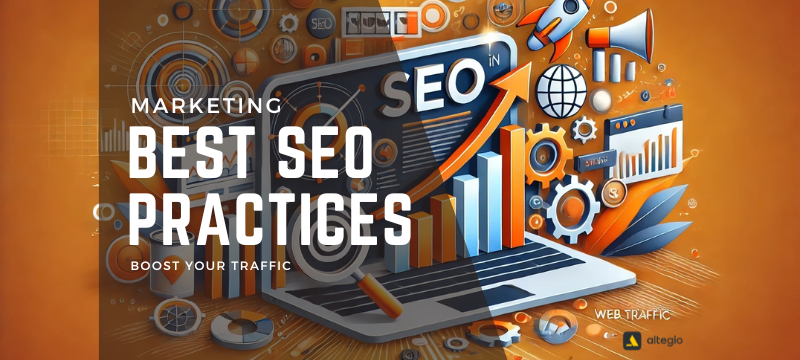SEO best practices in 2024 are tried-and-tested tactics for improving a website or brand’s visibility in search engine results pages without paying for ads. Following these best practices can help you improve brand awareness and get more organic traffic (unpaid clicks) from search engines like Google. Let’s dive into the top SEO strategies for 2024 that can help you stay ahead of the curve.
1. AI Content Creation
AI is becoming a key part of SEO. It can assist in numerous SEO tasks, including keyword research, content creation, content optimization, and many more.
Top AI Tools for SEO in 2024:
ChatGPT
- Key Features: 175 billion parameters, large language processing model.
- Cost: ChatGPT-3.5 is free; ChatGPT-4 costs $20/£16 per month.
- Pros: Saves time, thorough responses, excellent for keyword research.
- Cons: May struggle with complex questions, content can be identified by AI checkers.
Midjourney
- Key Features: Precise image generation from text prompts.
- Pros: User-friendly, high-quality visuals.
- Cons: Subscription costs, limited privacy for proprietary designs.
Surfer SEO
- Key Features: Cloud-based platform for SEO content planning and optimization.
- Pros: Powerful content editor, AI Outline Generator.
- Cons: Higher pricing compared to some competitors.
Frase.io
- Key Features: AI-powered content tool for SEO enhancement.
- Pros: Precise keyword guidance, supports multiple pages in a single document.
- Cons: No trial period, additional cost for unlimited use of AI writer.
2. Quality and Expert Content
Google emphasizes the importance of content that genuinely benefits users. In 2024, prioritize quality over quantity.
How to Create Quality Content:
- Comprehensive and Expert Content: Create thorough content that covers topics your audience finds interesting.
- Creating a Blog: Share valuable information, attract potential customers, and maintain engagement.
- Regular Updates: Regularly update old posts to keep them valuable and engaging.
- Content Compilation: Use tools like Frase.io for efficient content generation.
- Engaging Formats: Try different content formats like videos and podcasts.
- Creating FAQ Pages: Answer common questions clearly and concisely.
3. SERM: Working with Reputation
Search Engine Reputation Management (SERM) helps maintain a positive image on search engines and manage reputation issues.
Examples:
- Google Maps: Boosts visibility and engages local customers.

- Reviews: Enhances credibility and positively impacts SEO ranking.

- Employment Websites: Boosts public image and SEO.

4. E-E-A-T and YMYL
E-E-A-T (Experience, Expertise, Authoritativeness, Trustworthiness) and YMYL (Your Money or Your Life) are standards Google uses to evaluate content quality and reliability.
How to Improve E-E-A-T and YMYL:
- High-Quality Content: Offer authentic and useful content.
- Author Information and Transparent Disclosure: Show content creator credibility.
- Utilize Credible Resources: Connect to recognized references.
- Build a Strong Brand Image: Manage your online reputation.
- Backlinks: Get links from well-known sources.
5. SILO Structure
Silo structure in SEO organizes content by grouping and linking it based on specific topics.

Benefits:
- PageRank: Google rates a page’s importance based on links.
- Pyramid Site Structure: Intuitive navigation and better crawler understanding.

- Create Content Hubs: Specialize in a particular topic, emphasize authority, and speed up indexing.
6. Get High-Quality Backlinks
High-quality backlinks signal search engines that your content is valuable.
Methods:
- Create Link-Worthy Content: Make guides, tutorials, or case studies.
- Outreach: Collaborate with website or blog owners.
- Dropped Domains: Reactivate previously utilized domains.
- Crowd Marketing: Participate in events and respond to messages on social media.
- Local Partnerships: Collaborate with other local businesses.
- Question-and-Answer Platforms: Provide genuine value in comments.
- Submission Sites: Share links on directories, lists, and business listings.
7. Essential Technical SEO Audit
Ensure your website is properly crawled and indexed by search engines.
Key Areas:
- Crawlability: Ensure each URL returns with a 200 OK without errors.
- Indexability: Fix any client-side (4xx) or server-side (5xx) errors.
- Core Web Vitals: Optimize for loading speed, stability, and responsiveness.
8. Mobile-Friendly User Experiences
Mobile optimization involves fast loading times, easy navigation, and adaptable content.
Core Web Vitals:
- Largest Contentful Paint (LCP): Optimize for a good LCP score (2.5 seconds or less).
- First Input Delay (FID): Optimize for a good FID score (100 milliseconds or less).
- Cumulative Layout Shift (CLS): Optimize for a good CLS score (0.1 or less).
9. Conversion Rate Optimization (CRO)
Improve your conversion rates by optimizing user interactions on your website.
Strategies:
- Create Text-Based CTAs: Integrate CTAs within blog posts.
- Add Messages to High-Converting Pages: Use live chat software.
Run Tests on Landing Pages: Perform A/B tests to identify the best features.
Takeaway
The tips above are proven by experts at JetTRINET to drive up your organic traffic and improve your SEO strategy for 2024. Remember, every strategy takes time to show results, and various factors influence how quickly you’ll see improvements. Using a combination of these strategies will significantly enhance your SEO performance.
Learn how to elevate your e-commerce strategy by reading Top 5 Analytics Tools for Shopify in 2024 article.
Check out Best iPaaS Solutions in 2024 to find an iPaaS platform that aligns with your strategic goals, enhancing operations and adapting to the ever-evolving digital landscape.




